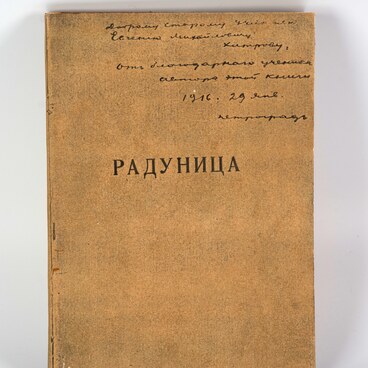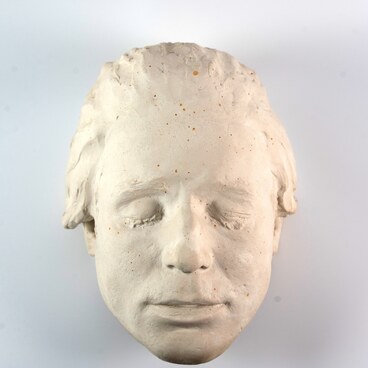The top hat of the poet was kept for a long time by Sophia Tolstaya-Esenina, granddaughter of Leo Tolstoi and the last wife of Sergei Esenin, who actively helped to her husband in his publishing activities and became one of the founders of the poet’s museum in Moscow. The headwear was brought to the museum collection by her friend Yugenia Yakubovskaya in 1979.
This top hat was bought by Esenin in Petrograd in 1919. The history of its purchase was described in detail by poet Anatoly Marienhof in his book A Novel Without Lies: “On the second day in Petersburg it began to rain. My parting was shining like a piano lid. Yesenin”s golden head turned brown and the curls were hanging like shabby chancellery commas. He felt himself aggrieved to the last degree. We were running from one shop to another begging to sell us a hat “without coupon”. In one shop, tenth in succession, a red-cheeked German standing at the cash register said: “Without coupon I can sell you only top hats”. Happy beyond belief, we were thankfully shaking the plump hand. In five minutes, ghostly Petersburgers were gazing at us, stickjaws sellers were roaring with laughter looking after us, and an amazed militiaman demanded to produce our papers. This is a true history of appearance of the legendary top hats exclusive in the revolution, which were glorified by the mob and berimed by poets’.
The top hat well seen from far away was for the poet not a simple headwear, but the sign of his exceptional nature and symbol of success: ‘At the site a group of students lifted Yesenin on their hands and started to toss him. He was flying upwards, while holding the top hat on the breast with both hands’, — remembered Matvei Roizman, poet and writer of memoirs.
The top hat often cause lough and misunderstanding among Yesenin’s contemporaries. In particular, Galina Benislavskaya, journalist and one of the poet’s sweethearts, wrote: ‘The top hat is as becoming to Yesenin as a straw hat is to a horse. He is of small stature; a high top hat on his head — a comic cinematographic figure’.
The top hat also figures in the poems of Yesenin, becoming a permanent attribute of his persona — hooligan poet. For instance, there are the following lines in the Hooligan’s Confession:
Wasn’t it you, whose heart froze in fear of his life,
When he was dipping his feet in the autumn ponds?
And now he wears a top hat and patent leather shoes.
The top hat is also mentioned in ‘I will not deceive myself…’ and ‘The Dark Man’.
This top hat was bought by Esenin in Petrograd in 1919. The history of its purchase was described in detail by poet Anatoly Marienhof in his book A Novel Without Lies: “On the second day in Petersburg it began to rain. My parting was shining like a piano lid. Yesenin”s golden head turned brown and the curls were hanging like shabby chancellery commas. He felt himself aggrieved to the last degree. We were running from one shop to another begging to sell us a hat “without coupon”. In one shop, tenth in succession, a red-cheeked German standing at the cash register said: “Without coupon I can sell you only top hats”. Happy beyond belief, we were thankfully shaking the plump hand. In five minutes, ghostly Petersburgers were gazing at us, stickjaws sellers were roaring with laughter looking after us, and an amazed militiaman demanded to produce our papers. This is a true history of appearance of the legendary top hats exclusive in the revolution, which were glorified by the mob and berimed by poets’.
The top hat well seen from far away was for the poet not a simple headwear, but the sign of his exceptional nature and symbol of success: ‘At the site a group of students lifted Yesenin on their hands and started to toss him. He was flying upwards, while holding the top hat on the breast with both hands’, — remembered Matvei Roizman, poet and writer of memoirs.
The top hat often cause lough and misunderstanding among Yesenin’s contemporaries. In particular, Galina Benislavskaya, journalist and one of the poet’s sweethearts, wrote: ‘The top hat is as becoming to Yesenin as a straw hat is to a horse. He is of small stature; a high top hat on his head — a comic cinematographic figure’.
The top hat also figures in the poems of Yesenin, becoming a permanent attribute of his persona — hooligan poet. For instance, there are the following lines in the Hooligan’s Confession:
Wasn’t it you, whose heart froze in fear of his life,
When he was dipping his feet in the autumn ponds?
And now he wears a top hat and patent leather shoes.
The top hat is also mentioned in ‘I will not deceive myself…’ and ‘The Dark Man’.



